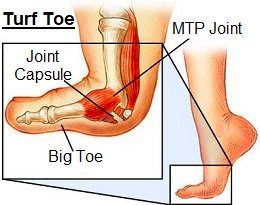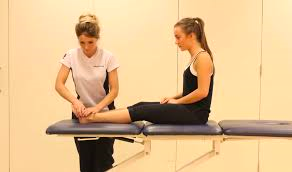What is Turf Toe?
By Nigel ChuaMedically known as metatarsophalangeal (MTP) joint sprain, turf toe is an injury to the main joint of the big toe.
This injury occurs when the big toe is forced into an extreme position of hyperextension (where the toe moves back towards the top of the foot past its normal range of motion).
It happens moreso in sports and athletic environments, particularly in football, such as when an athlete pushes off to sprint or is tackled with the front of the foot fixed and jammed into the ground, causing the toe to get stuck or caught in a hyperextended position.
The good news is that in most cases, a turf toe injury does not require surgery and can be treated effectively by our senior physiotherapists.
WHAT IS TURF TOE?

There are two joints in the big toe.
These joints allow the big toe to move in an upward motion and bend in a downward motion. Our big toe plays a significant role in our ability to walk and run; when the foot touches the ground and prepares to take another step, the big toe is the last joint through which the foot pushes off to move the body forwards.
The primary joint that this motion occurs through is the metatarsophalangeal joint, where the metatarsal, the first long, straight bone of the foot, attaches to the phalange, the first shorter bone of the toe.
If the big toe is forced into an extremely unnatural position, the MTP joint and surrounding structures may be injured. These structures may include:
- ligaments
- muscle tendons
- the small bones that sit under the big toe, called the sesamoid bones.
All of these structures play a role in maintaining the integrity and function of the MTP joint; they are often grouped together and termed the plantar complex. Sometimes, one of the soft-tissue structures is simply stretched when the toe is bent back towards the top of the foot.
However, a turf toe injury may involve
- a subluxation (where one bone of the joint slips out of place, but comes back to its normal position)
- or a dislocation (where the two bones of the joint are completely separated)
HOW DOES IT FEEL?
The most common symptoms associated with a turf toe injury are:
- Localized pain at the MTP joint
- Feeling a "pop" at or around the MTP joint at the time of the injury
- Swelling
- Bruising
- Tenderness to touch
- Cramping in the arch of the foot
- In more severe injuries, a disfiguring of the MTP joint (as in a dislocation)
HOW IS IT DIAGNOSED?
Turf toe injuries are typically classified into grades 1 to 3 to describe the severity of the injury and to guide treatment:
- Grade 1: stretching of the plantar complex
- Grade 2: partial tearing of the plantar complex
- Grade 3: complete tearing of the plantar complex.
Diagnosis of a turf toe injury starts with an interview to learn the mechanism of injury and your symptoms.
Our senior physiotherapists will perform a gentle clinical examination to assess the toe's movement and muscle function as well as to note any swelling or tenderness in the area. We may ask you if you are able to walk on your foot and if so, will analyze your gait pattern.
If we suspect a fracture of one of the bones or a tearing of the muscle-tendon unit, then we may refer you to an orthopedic physician who specializes in foot and ankle injuries for diagnostic imaging (i.e., x-ray, MRI).
HOW OUR SENIOR PHYSIOTHERAPISTS CAN HELP YOU

Immediately following a turf toe injury, the RICE protocol is recommended: Rest, Ice, Compression, and Elevation (Refer to our RICER article on immediate treatments post injuries).
The goal of the RICE protocol is to
- decrease pain
- decrease swelling
- protect the joint from further injury
until it can be more thoroughly assessed. Most turf toe injuries do not require surgery and are treated with physical therapy.
The physiotherapy treatments depends on the severity of the injury.
Grade 1
To treat a Grade 1 injury, we may use narrow athletic tape to immobilize your big toe with your second toe to restrict painful motion. We may also place a firm insert in your shoe to limit motion and promote healing.
In many cases, an athlete may be able to return to sport soon after a Grade 1 injury.
Grade 2
Treating Grade 2 injuries may require immobilizing the foot in a brace or walking boot, and allowing several weeks of rest.
Grade 3
Treatment of Grade 3 injuries is dependent on the severity of the damage to the structures of the foot. Surgery may be required if there is
- a fracture of a bone
- damage to the cartilage (the tissue that lines the bones of the joints)
- a complete tearing of the tendon
- excessive movement of the joint that causes repetitive instability (subluxation or dislocation).
In each case, our senior physiotherapists will work with you to design an individualized treatment program specific to the nature of your condition and your goals. Treatment may include:
Range of Motion Exercises
It is important to regain a full range of motion of your big toe. Your motion may be limited after a turf toe injury, particularly one that requires immobilization in a brace or boot.
We will teach you gentle stretching exercises to help regain motion.

Muscle Strengthening
It is common to lose strength in the muscles of your leg, particularly around your foot and ankle, after a turf toe injury due to the limited weight-bearing and activity that is required to allow the injury to heal.
We will determine which muscles are weak and teach you specific exercises to treat them, such as strengthening with
- resistance bands
- balance activities
- functional activities, like stair climbing.
Manual Therapy
Our senior physical therapists in Phoenix Rehab use manual (hands-on) therapy to gently move and manipulate muscles and joints to improve their motion and strength. These techniques can target areas that are difficult to treat on your own.
Manual therapy can be especially effective for joints that become stiff following immobilization. With a turf toe injury, we will use different techniques to mobilize your big toe as well as the other joints of your foot and ankle that may have become stiff during your recovery.
Patient Education
We will educate you on the dos and don’ts following a turf toe injury to ensure that your recovery is a smooth one.
We will work with you to develop an individualized rehabilitation program, including expected timelines and goals to give you a roadmap for your return to full activity.
Pain Relief
We may use pain relief modalities such as
- ultrasound therapy
- radio-frequency Indiba physiotherapy
- cold therapy
- heat therapy
- customized splinting
Browse other articles by category
Physiotherapy for Knee Pain Physiotherapy For Slipped Disc Physiotherapy for Neck Pain PHYSIOTHERAPY
PHYSIOTHERAPY
 Hand Therapy
Hand Therapy
 Alternative
Alternative
 Massage
Massage
 Traditional Chinese Medicine Treatment
Traditional Chinese Medicine Treatment
 Rehab
Rehab
 Physiotherapy For Lower Back Pain
Physiotherapy For Shoulder Pain
Orthopedic Doctors, Insurance & Healthcare
Physiotherapy For Upper Back Pain
Frozen Shoulder
Physiotherapy for Back Pain
Physiotherapy For Lower Back Pain
Physiotherapy For Shoulder Pain
Orthopedic Doctors, Insurance & Healthcare
Physiotherapy For Upper Back Pain
Frozen Shoulder
Physiotherapy for Back Pain

 Whatsapp us now
Whatsapp us now